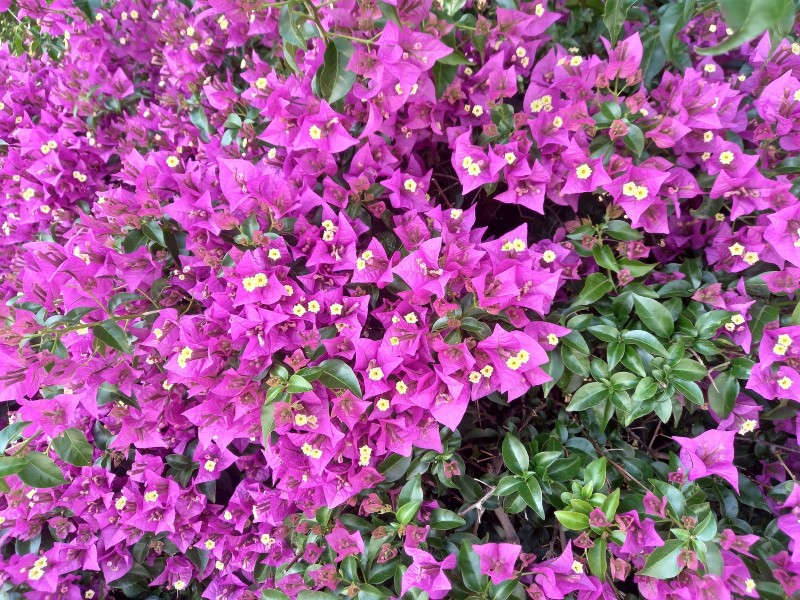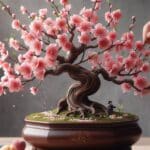When it comes to growing bonsai trees, you likely have always assumed that you have to choose species that meet one of two criteria – they have interesting root systems or they have beautiful flowers.
Those days have ended. Now, there are plenty of flowering bonsai trees you can grow. These not only offer gorgeous appeal in their delicate root systems, but also in their elegant flowers. Most flowering bonsai tree species can be styled and pruned using the same techniques you’d follow for other bonsai tree species – and they are easy to care for, too.
Here are some of the most popular flowering bonsai trees as well as tips you can use to help you get started with growing them.
Interesting Facts about Bonsai Trees with Flowers
| Height | ~15-48”, depending on species |
| Width | ~5-15”, depending on species |
| Sunlight | Full sunlight, depending on species |
| Flowering Time Length | 1-3 months, depending on species |
| Lifespan | Varies |
Common Types of Flowering Bonsai Trees
Apple
Apple trees are some of the most common species grown as flowering bonsai specimens and fruiting bonsai trees. While you can grow just about any kind of apple tree in the bonsai style, the best options are those that are tropical, such as pitch apple and monkey apple (Clusia rosea and Annona glabra, respectively).
Apple bonsai produces lovely white and pink flowers along with coin-sized fruits. These aren’t usually edible since they’re so small, but you’ll love looking at the dark green leaves and delicate flowers of this bonsai species regardless.
Azalea
Azaleas aren’t just popular as backyard shrubs – they’re also popular bonsai specimens. Azaleas, Rhododendrons, add gorgeous blooms in shades like red, pink, and white to your collection. They have attractive leaves, too, so you can keep things interesting even in the off-season. Azalea bonsai tree is also easy to shape into compact forms.
Bahama Berry
As you might expect from the name of this bonsai specimen alone, the Bahama berry will lend a tropical feel to your bonsai collection. Nativ to the Bahamas island of Inagua, this tree is tropical, a member of the Vervain family and known scientifically as Nashia inaguensis.
Bougainvillea

Though its name might be hard to pronounce, Bougainvillea, or Bougainvillea glabra, is another popular choice when you’re on the hunt for beautiful bonsai trees. Named after the French Navy Admiral Louis Antoine de Bougainville, the bougainvillea tree is technically a woody vine tentative to South America. Bougainvillea bonsai tree produces gorgeous yellow flowers and pink or purple leaves.
Cape Honeysuckle
Tecoma capensis, or the Cape Honeysuckle, is another popular bonsai variety to consider. It offers bright orange blooms and is best grown in full sunlight.
Cherry

There are several species of cherry trees you can grow in the bonsai fashion, all of which belong to the Prunus genus. There are more than 430 varieties you can choose from, in fact!
Bonsai cherry tree can be somewhat difficult to grow for beginners after the seedlings have emerged but are easy to start from seed.
Crepe Myrtle
Lagerstroemia, or Crepe Myrtle, has a variety of interesting traits that make it perfect for bonsai growing. It has attractive bark that sheds and varies in color along with deciduous leaves that will drop off come winter. It grows best in lots of sunlight and produces flowers that are usually pink.
Hibiscus

If you thought you had to live in the tropics in order to enjoy flowers as beautifully colored as those from a hibiscus, think again. A hibiscus bonsai tree, or Hibiscus rosa-sinensis, is sure to captivate when grown indoors in any climate.
You can find these hibiscus trees with a variety of flower colors, including white, yellow, red, and purple. You’ll need to stay on top of the large flowers and leaves to make sure they don’t get overgrown, though.
Pomegranate
The pomegranate tree, or Punica granatum, is another intriguing species to cultivate through the practice of bonsai. It is a deciduous tree whose leaves will fall off each winter, but after the bland winter season has passed, you’ll notice striking orange flowers and later, teeny-tiny fruits. The twisted trunk of this bonsai species is sure to captivate, too.
Powder Puff
Calliandra, or the powder puff, is a unique genus of trees. There are multiple varieties to choose from with flowers that look like, as you might guess, little powder puffs! Most flowers are pink or white, but this varies depending on the cultivar. You’ll love looking at the thick trunk and bright green leaves, too.
Wisteria

Wisteria plants, or Wisteria sinensis, can be found growing in many parts of the world, including Europe, Asia, and the United States. You’ll love the gorgeous purple flower produced by these bonsai trees, which are technically shrubs. You will have to be patient, though, as bonsai wisteria takes many years for them to actually produce any blooms.
Growing Flowering Bonsai Trees from Seed or by Propagation
Flowering bonsai trees can be started both from stem cuttings as well as from seeds. You can also use a naturally stunted flowering tree transplanted in a pot.
How to Care for Flowering Bonsai Trees
Here are some tips for bonsai tree maintenance and care:
Sunlight
In general, flowering bonsai trees require a bit more sunlight than non-flowering trees. So if you are growing a flowering indoor bonsai tree, you will need to move your bonsai pot to where there is at least 4 hours of sunlight daily. The extra light is necessary to help them generate either flowers or fruits. When growing these bonsai plants indoors, your best option is to place your plant on a window with southern exposure so it gets a full day of sunlight.
Watering
Proper watering is essential for your bonsai. Each species will have different requirements, but regardless, it’s important to never let your bonsai get completely dry. Water when the top of the soil looks dry. If you aren’t sure, stick your finger into the soil. If it feels dry at all, it’s time to water. Most species require only once a week watering during the winter and daily watering in the summer.
Fertilizing
Fertilization requirements for your bonsai will vary depending on what kind of plant you are growing. However, in most cases, you’ll want to use a bonsai-specific fertilizer that contains balanced amounts of nitrogen, phosphorus, and potassium.
Potting and Repotting
How often you need to repot your bonsai plant will vary depending on the species you are cultivating. In most cases, you should repot every two years, either after flowering or in the spring. Prune the roots carefully as they tend to be thin with many flowering bonsai species.
When you repot your plant, make sure you put it in bonsai-specific potting soil. The ingredients will allow water to drain while also retaining moisture and allowing the roots to breathe.
Pruning Flowering Bonsai Trees
If you have just purchased your flowering bonsai tree, chances are, you won’t need to prune it for a while. You only need to trim or prune if you are trying to shape the plant to a certain look. Otherwise, pruning can be done later on to remove thicker or overgrown branches.
It is also important to prune if you notice that the tree is bearing so many flowers that it is causing the roots or limbs of the tree to become stunted or sick looking. Make sure the flowers are distributed evenly on the plant and are roughly the same size. In most cases, the best time to prune is in the fall or early spring, before new growth has appeared.
Pests and Diseases
The kinds of pests and diseases that may plague your bonsai flowers depending on which species you are growing. However, certain conditions, like low humidity, can predispose your indoor-grown plant to pests like spider mites. You can usually prevent most pests and diseases by limiting overwatering, spritzing with a spray bottle to boost humidity instead. Treat with pesticides and fungicides (to address fungal diseases) as needed.
Where to Buy Flowering Bonsai Trees
Purchase your flowering bonsai tree from a reputable source. If proper care is given to your tree – and if it is purchased from reliable stock – you can expect it to live for decades. If you buy a bonsai tree blooming with tiny white flowers, you need to be extra careful with transportation so the flowers won’t fall down.
See more: Bonsai fruit trees
*image by [email protected]/depositphotos







